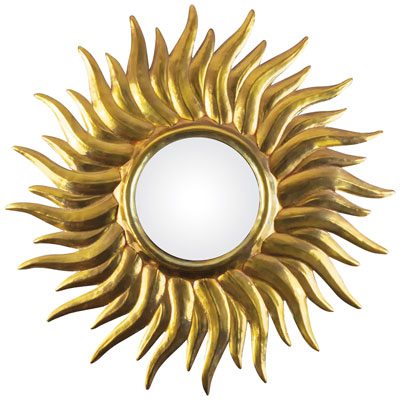The Sunburst Design Motif Is No Flash in the Pan
Writer Ren MillerThis bright star has inspired home décor for centuries, everything from decorative mirrors to designs on furniture and fabric to wood inlay floors and even Midcentury Modern clocks
CLICK HERE TO SIGN UP FOR OUR DESIGN DIGEST NEWSLETTER

This antique sunburst wall mirror with convex glass and wavy brass rays was made around 1890 in France. At press time, it was available on 1stDibs for $2,045.
The sun rises and sets quickly on some interior design trends, but it shines forever on the ones that go on to become classics. The sun itself is in the latter category.
Sunbursts have appeared in all types of interiors from earliest recorded history, including churches, commercial buildings and residences. Today, they are often found in the form of decorative mirrors, but over the years they’ve also been carved into furniture, printed on fabrics, pieced together for wood inlay floors and even molded into Midcentury Modern clocks.
Aside from typically having a round center, sunburst designs are limited only by their creators’ imagination. The sun’s rays might touch, overlap or have spaces between them. They can be identical or varying lengths; formed into straight, tapered, curved or wavy lines; and made of any material from metal to wood to resin and more. The shape has led some people to call them starbursts, but the golden color of most versions has made sunburst the more common name.
When the sunburst motif is applied to mirrors, the reflective center is typically very small and the rays very large, making them more decorative than utilitarian. You will find sunburst mirrors to fit virtually any decorating style, so it’s no wonder they remain popular.
The origin of sunburst designs is open to speculation. Prehistoric rock carvings capture the earliest known sunburst motifs, although their intention was more likely to tell a story than to decorate a cave home. The sunburst became more common during medieval times with the growth of the Roman Catholic Church and ecclesiastical art. The theory is that the sun symbolized the idea of God looking down to worshippers. The sunburst was shown sometimes on its own, other times as a “halo” around the head of a saint or angel depicted in a statue, painting or carving.
The emblem seemed tailor-made for Louis XIV of France, who reigned from 1643 until 1715 and was known as the Sun King. True or not, legend says he rose early every morning to admire himself in a sunburst-style mirror, with his head in the center of the rays of the frame. Among other things during his long reign, he established his own glassworks, leading to a vast improvement in the quality and size of mirrors as well as to the establishment of the Hall of Mirrors at the Palace of Versailles. The Hall of Mirrors reflected not only Louis XIV’s fascination with mirrors but, along with adjoining salons, was intended to illustrate his power. In fact, he chose the head of Apollo surrounded by rays of light as his personal emblem.
Even with establishment of glasswork factories, mirrors remained expensive and were owned only by royalty and the wealthy through much of the 18th century. By the early 19th century, however, production methods improved and expanded, and mirrors became more common in average homes.
With the birth of the Hollywood Regency period (1920s-1950s), the sunburst mirror made real inroads in interior design. Iconic designers such as Dorothy Draper used sunburst mirrors to set a glitzy, glamorous ambience in the homes of Hollywood’s elite and at luxury resorts around the world.
In the 1950s and into the 1960s, sunburst mirrors took on a Midcentury Modern vibe with smaller round mirrors attached to slender rays.
Today, sunburst mirrors are used in various ways depending on style and size, including hanging over a fireplace or console, in a grouping with artwork, or sitting on a shelf bringing light into a dark corner. Whatever the style, sunburst mirrors represent the energy and life force of the bright star for which they are named while adding glamour and drama wherever they are placed.
